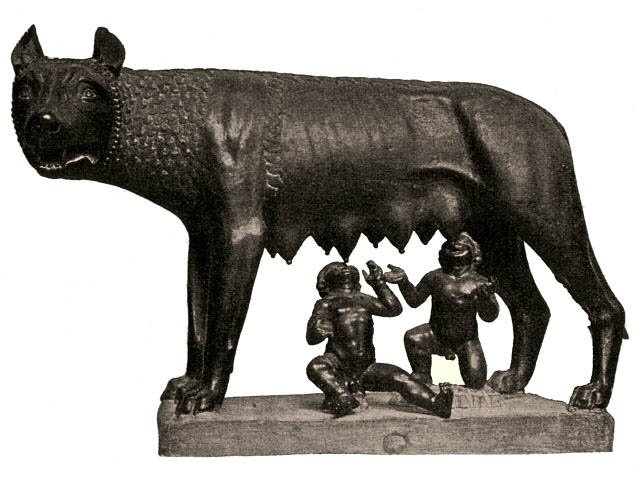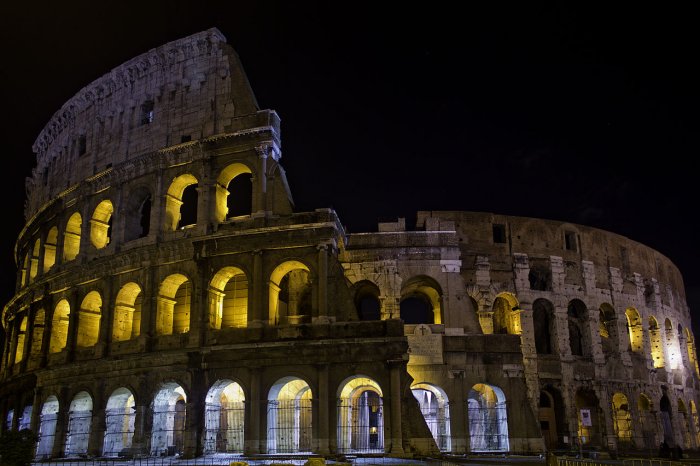Why Is Rome Called ‘The Eternal City’?
Conny Waters - AncientPages.com - Have you ever wondered why Rome became known as the "Eternal City? The city's nickname can be traced to an ancient myth, ancient historical writings, and the old Romans' beliefs in the greatness of their city.
The Capitoline she-wolf with the boys Romulus and Remus. Museo Nuovo in the Palazzo dei Conservatori, Rome. Rome is much older than the myth about Romulus and Remus. Benutzer:Wolpertinger - Public Domain
According to an ancient legend, the city of Rome was founded on April 21, 753 B.C. by Romulus.
Romulus and Remus were twin brothers and sons of the god Mars. Thrown into the river Tiber by a wicked uncle hoping they would drown, the small boys were rescued by a wolf who fed them.
When Romulus and Remus became adults, they decided to establish their city, and each set out to find the best location. They were later discovered and cared for by a shepherd and his wife: Faustulus and Acca Larentia. One day, the two brothers quarreled over where the site should be, and his brother killed Remus.
It left Romulus the sole founder of the new city, and he gave his name to it – Rome. Now, this is just a myth, and the history of Rome goes much further back in time.
According to the legend, Romulus became the first king of Rome in 753 BC. Legends say Numa Pompilius was the second king of Rome, but he was not a warrior king but a statesman and politician.
Nevertheless, archaeologists have discovered artifacts that prove Rome was inhabited much earlier than 753 B.C.
Rome was known as the "Eternal City" because civilizations had lived there for thousands of years. The ancient Roman Empire was mighty, and it had many enemies. Yet, ancient Romans managed to defeat the Carthaginians and Etruscans and extended their empire throughout Europe and Africa. No one underestimated the greatness of the ancient Roman Empire.
Between c. 100 B.C to around 400 A.D, the city of Rome was the largest in the world.
Around 500 A.D., Empire's populace grew to an estimated 50 to 90 million. At the time, this was roughly 20% of the world's population.
Roman writers and poets boasted about their city's greatness. In his epic poem The Aeneid, the poet Virgil wrote the line imperium sine fine – an empire without end.
The first explicit reference to Rome as the Eternal City occurred in the 1st century B.C. Poet Albius Tibullus (55 BC - 19 BC) wrote ‘Romulus aeternae nondum formaverat urbis moenia, consorti non habitanda Remo’ – Tibullus, from Elegies.
In other words, 'not yet had Romulus drawn up the Eternal City's walls, where Remus as co-ruler was fated not to live.
Ancient writers such as Ovid and Livy also took up the expression.
It's no wonder that ancient Romans thought that whatever happened to the rest of the world, Rome would last forever. Rome became known as the "Eternal City."
Rome is called the "Caput Mundi" (Capital of the World). Although the ancient Roman Empire is long gone, we still call it the "Eternal City."
Romulus and Remus were twin brothers and sons of the god Mars. A wicked uncle threw them into the river Tiber, hoping they would drown, but a wolf who fed them rescued them.
They were later discovered and cared for by a shepherd and his wife: Faustulus and Acca Larentia. When Romulus and Remus became adults, they decided to establish their own city, and each set out to find the best location. One day, the two brothers quarreled over where the site should be, and his brother killed Remus.
This left Romulus the sole founder of the new city, and he gave his name to it – Rome. Now, this is just a myth, and the history of Rome goes much further back in time.
According to the legend, Romulus became the first king of Rome in 753 BC. Legends say Numa Pompilius was the second king of Rome, but he was not a warrior king but rather a statesman and politician.
Nevertheless, archaeologists have discovered artifacts showing that Rome was inhabited much earlier than 753 B.C.
Rome was known as the “Eternal City” because civilizations had lived there for thousands of years. The ancient Roman Empire was very powerful and had many enemies. Yet, the ancient Romans managed to defeat the Carthaginians and Etruscans and extend their empire throughout Europe and Africa. No one underestimated the greatness of the ancient Roman Empire.
Between 100 B.C. to around 400 A.D., Rome was the largest city in the world. Around 500 A.D., the Empire's populace grew to an estimated 50 to 90 million inhabitants. At the time, this was roughly 20% of the world's population.
Colosseum at night. Image credit: Ramesh - CC BY-SA 3.0
Roman writers and poets boasted about their city’s greatness. In his epic poem The Aeneid, the poet Virgil wrote the line imperium sine fine – an empire without end.
The first explicit reference to Rome as the Eternal City occurred in the 1st century B.C. Poet Albius Tibullus (55 BC - 19 BC) wrote ‘Romulus aeternae nondum formaverat urbis moenia, consorti non habitanda Remo’ – Tibullus, from Elegies.
In other words, ‘not yet had Romulus drawn up the Eternal City’s walls, where Remus as co-ruler was fated not to live.’
The expression was also taken up by ancient writers such as Ovid and Livy.
It’s no wonder that ancient Romans thought that whatever happened to the rest of the world, Rome would last forever. Rome became known as the “Eternal City”.
Rome is also called the "Caput Mundi" (Capital of the World). The ancient Roman Empire is long gone, but we still call Rome the “Eternal City.”
First version of this article was published on Ancient Pages on April 4, 2018
Written by Conny Waters – AncientPages.com Staff Writer
Copyright © AncientPages.com All rights reserved. This material may not be published, broadcast, rewritten or redistributed in whole or part without the express written permission of AncientPages.com
More From Ancient Pages
-
 Mag Mell: Irish Tradition Of Otherworldly Paradise That Could Be Reached Through Death And Glory
Celtic Mythology | Feb 26, 2019
Mag Mell: Irish Tradition Of Otherworldly Paradise That Could Be Reached Through Death And Glory
Celtic Mythology | Feb 26, 2019 -
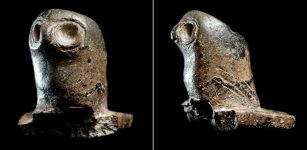 Enigmatic 2,000 -Years-Old Carved Stone Owl Pipes – An Ancient Unsolved Secret Of Illinois
Artifacts | Oct 4, 2018
Enigmatic 2,000 -Years-Old Carved Stone Owl Pipes – An Ancient Unsolved Secret Of Illinois
Artifacts | Oct 4, 2018 -
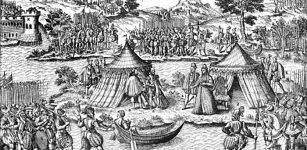 On This Day In History: Edict Of Longjumeau Was Signed And Ended Second War of Religion – On Mar 23, 1568
News | Mar 23, 2017
On This Day In History: Edict Of Longjumeau Was Signed And Ended Second War of Religion – On Mar 23, 1568
News | Mar 23, 2017 -
 Crypts, Coffins, Artifacts And Wooden Church Remains Under The Floor Of Basilica In Poland
Archaeology | Mar 5, 2018
Crypts, Coffins, Artifacts And Wooden Church Remains Under The Floor Of Basilica In Poland
Archaeology | Mar 5, 2018 -
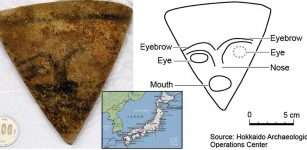 Jomon Period: Triangle-Shaped Stone Artifact Depicting Human Face Found For The First Time In Japan
Archaeology | Dec 25, 2017
Jomon Period: Triangle-Shaped Stone Artifact Depicting Human Face Found For The First Time In Japan
Archaeology | Dec 25, 2017 -
 Unique Viking Age Silver Treasure Found On Farm Near Stockholm In Sweden
Archaeology | Nov 12, 2020
Unique Viking Age Silver Treasure Found On Farm Near Stockholm In Sweden
Archaeology | Nov 12, 2020 -
 Prehistoric Bone Tool ‘Factory’ Shows Human Ancestors Had Advanced Reasoning Skills One Million Years Earlier Than Believed
Evolution | Mar 11, 2025
Prehistoric Bone Tool ‘Factory’ Shows Human Ancestors Had Advanced Reasoning Skills One Million Years Earlier Than Believed
Evolution | Mar 11, 2025 -
 The Untold Story Of Mexico’s Ancient Giant Indians – Cunning Plan And The Evil Nation – Part 2
Ancient Mysteries | Sep 23, 2019
The Untold Story Of Mexico’s Ancient Giant Indians – Cunning Plan And The Evil Nation – Part 2
Ancient Mysteries | Sep 23, 2019 -
 Strange Case Of The Italian Doppelganger – Collision Of Parallel Timelines? Part 2
Featured Stories | Oct 16, 2019
Strange Case Of The Italian Doppelganger – Collision Of Parallel Timelines? Part 2
Featured Stories | Oct 16, 2019 -
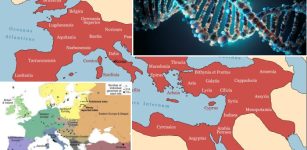 Ancient DNA Reveals How People Migrated During The Roman Empire
DNA | Feb 1, 2024
Ancient DNA Reveals How People Migrated During The Roman Empire
DNA | Feb 1, 2024 -
 Was Napoleon Bonaparte Defeated At Waterloo Because Of Volcanic Eruption?
Archaeology | Aug 22, 2018
Was Napoleon Bonaparte Defeated At Waterloo Because Of Volcanic Eruption?
Archaeology | Aug 22, 2018 -
 Legendary Mount Penglai Where The Eight Immortals Reside
Chinese Mythology | Feb 20, 2018
Legendary Mount Penglai Where The Eight Immortals Reside
Chinese Mythology | Feb 20, 2018 -
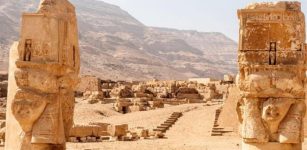 Cache Of 13,000 Ostraca Unearthed In Upper Egypt’s Sohag
Archaeology | Dec 21, 2021
Cache Of 13,000 Ostraca Unearthed In Upper Egypt’s Sohag
Archaeology | Dec 21, 2021 -
 Ancient Footprints Offer Evidence Humans Wore Shoes 150,000 Years Ago – Scientists Say
Archaeology | Sep 11, 2023
Ancient Footprints Offer Evidence Humans Wore Shoes 150,000 Years Ago – Scientists Say
Archaeology | Sep 11, 2023 -
 Earliest Document Written 2,100 Years Ago May Rewrite History Of The Basque Language
Archaeology | Nov 17, 2022
Earliest Document Written 2,100 Years Ago May Rewrite History Of The Basque Language
Archaeology | Nov 17, 2022 -
 Ice Age Mystery – Unexplained Disappearance Of North America’s Large Mammals – New Clues
Fossils | Jun 1, 2024
Ice Age Mystery – Unexplained Disappearance Of North America’s Large Mammals – New Clues
Fossils | Jun 1, 2024 -
 Mystery Of Vishaps, Armenia’s Ancient ‘Dragon Stones’ Solved
Archaeology | Sep 30, 2025
Mystery Of Vishaps, Armenia’s Ancient ‘Dragon Stones’ Solved
Archaeology | Sep 30, 2025 -
 Rare Iron Age Cauldrons And Their Almost Exact Replica Reveals Its Secrets
Archaeology | Aug 4, 2025
Rare Iron Age Cauldrons And Their Almost Exact Replica Reveals Its Secrets
Archaeology | Aug 4, 2025 -
 Pregnant Woman’s Remains With An 8-Month Fetus Unearthed At Ancient Taosibei Cemetery, Shanxi, China
Archaeology | Jun 13, 2022
Pregnant Woman’s Remains With An 8-Month Fetus Unearthed At Ancient Taosibei Cemetery, Shanxi, China
Archaeology | Jun 13, 2022 -
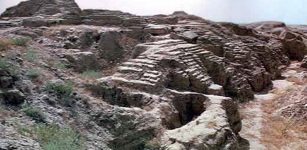 Ashur – First Capital And Powerful Religious Center Of The Assyrian Empire
Featured Stories | Jun 28, 2019
Ashur – First Capital And Powerful Religious Center Of The Assyrian Empire
Featured Stories | Jun 28, 2019

